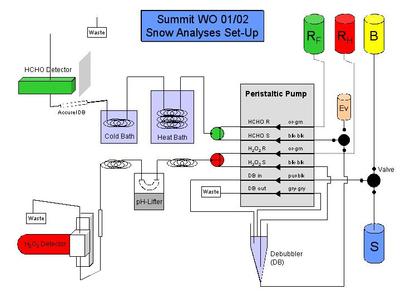
|
9 August, 20011000 bottles of snow... and plenty more out there too! Today I counted. I have collected and analyzed over 1000 bottles of snow since I have been here. I can collect it in my sleep now. (literally, I did a few three a.m. runs for snow) Once the snow is collected, it is stored until it is analyzed. On an average day I melt 50 bottles of snow. My PR (with help) was 149 bottles in one day. To see the collection process the snow story Here are the steps in the process. 1. Wash and prepare the bottles. 2. Dry the bottles in the hood overnight. 3. Weigh the bottles. 4. Prepare the data sheet to take to the field with the bottles ID number. 5. Collect the samples in fresh snow. Each sample that is collected has an ID number, note any characteristics of the snow that is put in the sample bottle. 6. Return to the lab, weigh the full bottles of snow. 7. Store them in the freezer until it is time to melt. 8. Once the instruments are warmed up, reagents made and standards run, begin sampling the snow that has been melted. 9. Each bottle is sampled for 3 minutes. 10. The sample goes into a small tube from there it meets with the reagents in a mixing "T". Through this process the reagents bond with the sample giving the sample the ability to react with the light beams in the sensors. There are two processes: one for each H2O2 and HCHO. Here they are... A. HCHO reaction: so called 'Hantz' reaction: HCHO reacts with 2,4- pentanedione and ammonia (NH3) to 3,5-diacetyl-1,4-dihydrolutidine (DDL). The latter is fluorescing (excitation wavelength 412 nm, emission at 510nm). B. H2O2 reaction: dimerisation of 4-ethylphenol with h2o2 in the presence of the enzyme peroxidase (two 4-ethylphenol molecules are bound together). The product is fluorescing at 310/400nm. Both reactions are pH-dependant, thus the pH lifter and/or buffer in the solution. The HCHO reaction is highly temp. dependent and can be sped up by with a higher temp. The schematic below, drawn of the snow system here, shows the entire process the samples go through. 11. Once the sample is in the instrument a flourescence signal is given off. This signal in millivolts is recorded in the data logger. 12. A graphical version of the signal is shown on the computer at the same time the computer records the data. 13. Once each bottle is emptied of snow, it is rewashed for another round! 1000 bottles and still counting.
Contact the TEA in the field at . If you cannot connect through your browser, copy the TEA's e-mail address in the "To:" line of your favorite e-mail package. |




